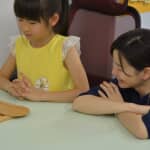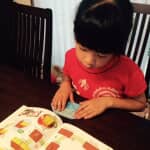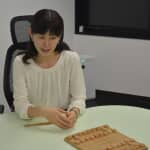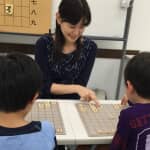Child-raising 4 November 2016
Enjoy Hyakunin Isshu with Children
At the beginning of Jun, rainy season will start soon, so it makes me a bit blue. Today, I would like to introduce Hyakunin Isshu (A traditional Japanese card game, one hundred poems by one hundred poets) that you can play and enjoy on a rainy day.
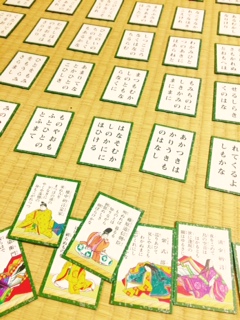
Hyakunin Isshu is a collection of one hundred Japanese poems . Those poems are called “Tanka,” which is Japanese traditional poetry with five lines with 31 syllables that are set in lines of 5, 7, 5, 7 and 7 syllables. The first three lines with 5, 7, 5 syllables are named “Kaminoku” and the last two lines with 7, 7 syllables are “Shimonoku.” Each poem’s Kaminoku is written on a card with a beautiful picture. And Shimonoku of that poem is written on a different card only in hiragana (cursive characters of Japanese phonograms). One set of Hyakunin Isshu has one hundred Kaminoku cards and hundred Shimonoku cards respectively. Before you start a game, you need to spread out Shimonoku cards on the floor.
Now you are ready to start a game. To enjoy Hyakunin Isshu, one person will read out a poem of Kaminoku on a card with a beautiful picture. Listening to the reader, players must identify a card with Shimonoku matching to the Kaminoku and flip, or swat in some cases, it.
In Japan, we are experiencing an unparalleled boom of “Karuta,” competitive Karuta in particular, which is a Japanese traditional card game played in the Japanese home, due to famous Manga (or Japanese cartoon) “Chiahyaburu” that has been made into a popular movie whose leading actress is Suzu Hirose, a rising star Japanese actress.
I heard that these days, some Japanese elementary schools have introduced Hyakunin Isshu as a part of their curriculum.
When I was in an elementary school, people were getting to hear and use the term “globalization.” Japan was at a turning point of its globalization, arguing whether English and Personal Computer should be mandatory for school.
At that time, Japanese people frantically tried to catch up the West who was a leader of IT. Without even noticing, that phase ended. What Japanese people are expected in this current global society is not to adopt things from outside Japan but to express identity as a Japanese in outside of Japan.
Recently, in many fields, the real value of traditional Japanese culture has been reevaluated. We have been offering information and posting articles in our blog. We will be waiting for your visiting our website.
The rest of this posting describes Hyakunin Isshu.
I have hardly ever played Hyakunin Isshu. I don’t have memories of enjoying it with my family at New Year holiday like other families. Actually, it was not my thing. I was just reluctant to learn all poems by heart as preparation for an exam. Almost nothing was soaked in my head.
Not surprisingly, despite the total time I spent I didn’t get a good score on the test. Nor could become cultivated. Oh, well!
Using this good opportunity to write this article about Hyakunin Isshu, I decided to relearn it for the first time in years, or in decades. So, I bought the set of Hyakunin Isshu.
I really, really regretted my attitude toward it. Because, I figured out that only a set of Hyakunin Isshu allowed me to enjoy it in several ways. I used this wonderful card game in just meaningless way, playing as New Year’s amusement, or preparing for a test reluctantly. What a waste!
I would love to share the three ways, which I got tips through playing it by myself yesterday, to appreciate the real value of this amazing card game.
1. With Your Ears
As I described before, a full set of Hyakunin Isshu is composed of one hundred Kaminoku cards and one hundred Shimonoku cards. Kaminoku cards are called “Yomifuda” used for reading, Shimonoku cards laid out on the floor, “Torifuda,” are for dealing. Listening to lines of Kaminoku the reader is reading out, you very possibly concentrate on the Shimonoku cards. Lines of Japanese poetry rhyme.
So, now I would recommend you to enjoy the beautiful rhythm created by the lines of Japanese syllable groups , not only to see one card after another.
“Mo-Mi-Ji-No-Ni-Shi-Ki Ka-Mi-No-Ma-Ni-Ma-Ni,” one of Shimonoku, is my cup of tea!
2. With Your Eyes
I have focused on Torifuda, Shimonoku cards. But, Yomifuda, Kaminoku cards are by far more beautiful and gorgeous.
On the surface of Yomifuda, there are lines of Kaminoku and the pictures of the poem’s composer, who are aristocrats or monks. Their costumes are elaborately painted, such as Juni Hitoe (twelve layered ceremonial kimono) that is regarded the supreme traditional costume for a Japanese woman. As a player of Hyakunin Isshu game, you seldom or never see Yomifuda. Don’t you think it’s ridiculous to give the reader all chances to appreciate beautiful pictures? You definitely need to see and catch aesthetic charm.
Speaking of eyes, your visual skills will be developed, playing this game. To spread out one hundred cards, you need space of one tatami mat (it’s about 910mm×1820mm.) While a Kaminoku is read out, you will run your eyes over the whole Shimonoku cards. While you are developing your visual skills, you could improve your concentration skills.
3. With Your Heart
To be honest, you can enjoy Hyakunin Isshu without complete memory of all one hundred cards by heart. It’s except for someone to become a A-grade student, or to become a player of competitive Karuta, of course. More important thing than remembering all by heart is to feel them by your heart.
I will give you one example: a very famous poem of Hyakunin Isshu composed by Kakinomono no Hitomaro. His official rank was not high, but in later years he was regarded as a perfect master of poetry. The meaning of the poem is that “the night sleeping apart from my dear wife is as long as the tail and wings of the pheasant. I spend the night in lonely solitude. (It is said the pheasant pairs sleep apart.) ” He composed this poem when he was about to be gone from his home for a long time duty.
He wrote a romantic love letter, using 31 syllables.
The selectors of Hyakunin Isshu, Fujiwara Teika, was a great master of poetry. It’s his credit that there are many to touch our heart strings in Hyakunin Isshu.
Only the language people of the past used differ from ours. However, we feel as they did in appreciating the seasons, missing home and lovers, or loving somebody. I learned that through Hyakunin Isshu.
Just one piece of paper board contains profound descriptions of feelings and scenes. This tells that traditional Japanese culture has real “style”.
What I learned from Hyakunin Isshu is that a true Japanese is now expecting to introduce this Japanese real “style” to people outside Japan.
